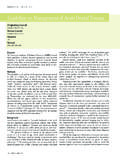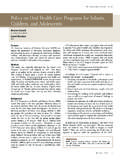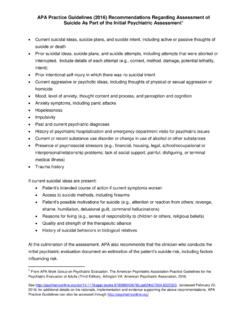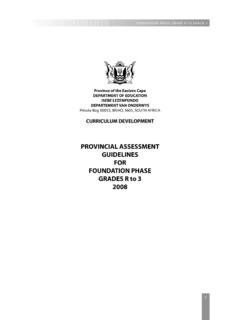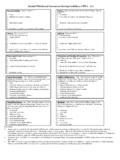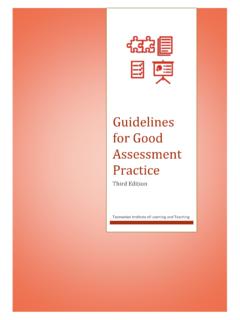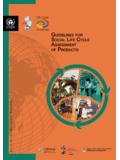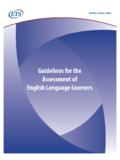Transcription of Guideline on Caries-risk Assessment and …
1 132 CLINICAL PRACTICE GUIDELINESREFERENCE MANUAL V 37 / NO 6 15 / 16 Originating Council Council on Clinical AffairsReview CouncilCouncil on Clinical AffairsAdopted 2002 Revised*2006, 2010, 2011, 2013, 2014 PurposeThe American Academy of Pediatric Dentistry (AAPD) recog-nizes that Caries-risk Assessment and management protocols can assist clinicians with decisions regarding treatment based upon caries risk and patient compliance and are essential elements of contemporary clinical care for infants, children, and adolescents. This Guideline is intended to educate health care providers and other interested parties on the Assessment of caries risk in contemporary pediatric dentistry and aid in clinical decision making regarding diagnostic, fluoride, dietary, and restorative Guideline is an update of AAPD s Policy on Use of a Caries-risk Assessment Tool (CAT) for Infants, Children, and Adolescents, Revised 2006 that includes the additional con- cepts of dental caries management protocols.
2 The update used electronic and hand searches of English written articles in the medical and dental literature within the last 10 years using the search terms caries risk Assessment , caries management, and caries clinical protocols. From this search, 1,909 articles were evaluated by title or by abstract. Information from 75 articles was used to update this document. When data did not appear sufficient or were inconclusive, recommendations were based upon expert and/or consensus opinion by experienced re- searchers and assessmentRisk Assessment procedures used in medical practice normally have sufficient data to accurately quantitate a person s disease susceptibility and allow for preventive Even though Caries-risk data in dentistry still are not sufficient to quanti- tate the models, the process of determining risk should be a component in the clinical decision-making Risk Assessment : 1.
3 Fosters the treatment of the disease process instead of treating the outcome of the disease. 2. Gives an understanding of the disease factors for a specific patient and aids in individualizing preventive discussions. 3. Individualizes, selects, and determines frequency of preventive and restorative treatment for a patient. 4. Anticipates caries progression or stabilization. Caries-risk Assessment models currently involve a combina-tion of factors including diet, fluoride exposure, a susceptible host, and microflora that interplay with a variety of social, cultural, and behavioral Caries risk Assessment is the determination of the likelihood of the incidence of caries (ie, the number of new cavitated or incipient lesions) during a certain time period7 or the likelihood that there will be a change in the size or activity of lesions already present.
4 With the ability to detect caries in its earliest stages (ie, white spot lesions), health care providers can help prevent Caries risk indicators are variables that are thought to cause the disease directly (eg, microflora) or have been shown useful in predicting it (eg, socioeconomic status) and include those variables that may be considered protective factors. Cur- rently, there are no Caries-risk factors or combinations of factors that have achieved high levels of both positive and negative predictive Although the best tool to predict future caries is past caries experience, it is not particularly useful in young children due to the importance of determining caries risk before the disease is manifest.
5 Children with white spot lesions should be considered at high risk for caries since these are precavitated lesions that are indicative of caries Plaque accumulation also is strongly associated with caries de- velopment in young ,13 As a corollary to the presence of plaque,14 a child s Mutans Streptococci (MS) levels3 and the age at which a child becomes colonized with cariogenic flora15,16 are valuable in assessing risk, especially in preschool children. Guideline on Caries-risk Assessment and Management for Infants, Children, and Adolescents* The 2013 revision was limited to modification of Table 1.
6 Caries-risk Assessment Form for 0-3 Year Olds (For Physicians and Other Non- Dental Health Care Providers). The 2014 revision was limited to use of toothpaste in young children. AMERICAN ACADEMY OF PEDIATRIC DENTISTRYCLINICAL PRACTICE guidelines 133 While there is no question that fermentable carbohydrates are a necessary link in the causal chain for dental caries, a sys- tematic study of sugar consumption and caries risk has con- cluded that the relationship between sugar consumption and caries is much weaker in the modern age of fluoride exposure than previously However, there is evidence that night-time use of the bottle, especially when it is prolonged.
7 May be associated with early childhood Despite the fact that normal salivary flow is an extremely important intrinsic host factor providing protection against caries, there is little data about the prevalence of low salivary flow in ,20 Sociodemographic factors have been studied extensively to determine their effect on caries risk. Children with immigrant backgrounds have three times higher caries rates than non- Most consistently, an inverse relationship be- tween socioeconomic status and caries prevalence is found in studies of children less than six years of Perhaps another type of sociodemographic variable is the parents history of cavities and abscessed teeth.
8 This has been found to be a predictor of treatment for early childhood ,24 The most studied factors that are protective of dental ca- ries include systemic and topical fluoride, sugar substitutes, and tooth brushing with fluoridated toothpaste. Teeth of chil- dren who reside in a fluoridated community have been shown to have higher fluoride content than those of children who reside in suboptimal fluoridated Additionally, both pre- and post-eruption fluoride exposure maximize the caries-preventive ,27 For individuals residing in non- fluoridated communities, fluoride supplements have shown a significant caries reduction in primary and permanent With regard to fluoridated toothpaste.
9 Studies have shown consistent reduction in caries Professional topical fluoride applications performed semiannually also reduce caries,30 and fluoride varnishes generally are equal to that of other professional topical fluoride The effect of sugar substitutes on caries rates have been evaluated in several populations with high caries Studies indicate that xylitol can decrease MS levels in plaque and saliva and can reduce dental caries in young children and adults, including children via their With regard to toothbrushing, there only is a weak relationship between frequency of brushing and decreased dental caries, which is confounded because it is difficult to distinguish whether the effect is actually a measure of fluoride application or whether it is a result of mechanical removal of The dental home or regular periodic care by the same prac- titioner is included in many Caries-risk Assessment models because of its known benefit for dental Risk Assessment tools can aid in the identification of reliable predictors and allow dental practitioners.
10 Physicians, and other nondental health care providers to become more actively involved in identifying and referring high-risk chil- dren. Tables 1, 2, and 3 incorporate available evidence into practical tools to assist dental practitioners, physicians, and Table 1. Caries-risk Assessment Form for 0-3 Year Olds59,60 (For Physicians and Other Non-Dental Health Care Providers) FactorsHigh Risk Low RiskBiological Mother/primary caregiver has active cavitiesYe s Parent/caregiver has low socioeconomic statusYe s Child has >3 between meal sugar-containing snacks or beverages per dayYe s Child is put to bed with a bottle containing natural or added sugarYe s Child has special health care needsYe s Child is a recent immigrantYe sProtective Child receives optimally-fluoridated drinking water or fluoride supplementsYe s Child has teeth brushed daily with fluoridated toothpasteYe s Child receives topical fluoride from health professionalYe s Child has dental home/regular


